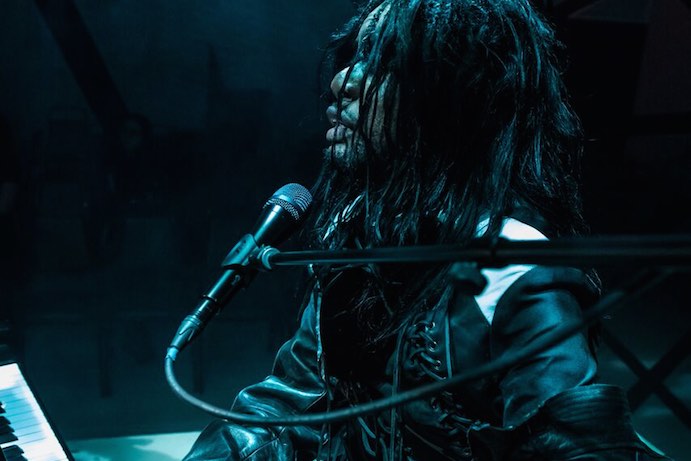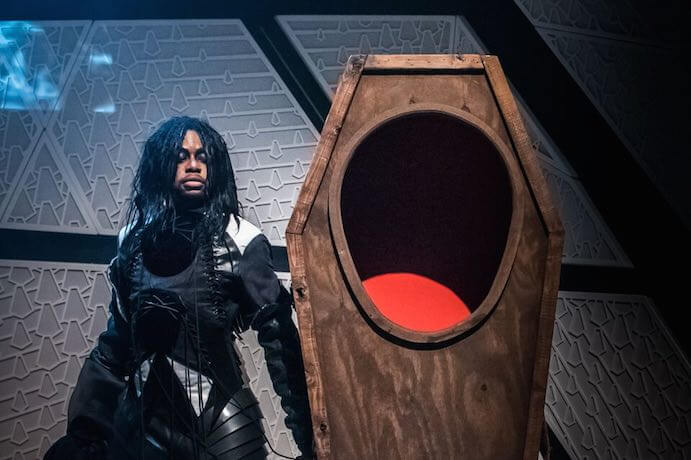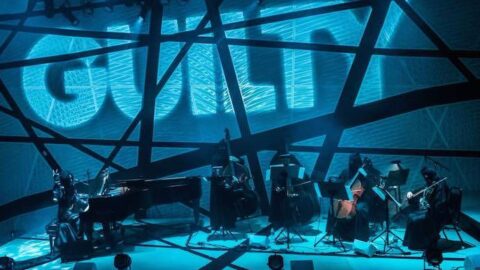On Saturday, January 14, National Sawdust opened its doors for the New York premiere of M. Lamar and Hunter Hunt-Hendrix’s multimedia concert piece, Funeral Doom Spiritual, one of this year’s final offerings in the fifth annual PROTOTYPE Festival. PROTOTYPE, which has come into its own as the “premier festival of opera-theatre and music-theatre” is a collaboration between Beth Morrison Projects and HERE, two of New York City’s eminent organizations supporting the “creation and presentation of contemporary, post-classical, multi-disciplinary opera-theatre and music-theatre work.” As a sounding board for complete performances and works-in-progress alike, the festival is unique in keeping apace with both established contemporary artistic voices and those whose work is just beginning to emerge and take shape.
In careful alignment with the festival’s agenda, Funeral Doom Spiritual offered a complex and multi-dimensional vision potently described in manifesto-like program notes, which outlined themes evolving from the historic devaluation and trivialization of black life in America to past and future emancipation and the possible transcendence to a new type of free, black man; what M. Lamar–co-writer and the lead character, vocalist and pianist in the performance–describes as a “NEGROGOTHIC [sic] devil worshipping free black man in the blues tradition.” This transcendence (or ‘becoming,’ as the author articulates it) is offered through the catalyst of the work itself. M. Lamar’s notes go on to proclaim that the work draws on themes of the apocalypse, rapture and judgement found in Negro spirituals to create “spaces of trauma, recovery and transformation” when layered into a complex strata of “video, sculpture, photography, sound and performance.” Within this context, M. Lamar offers himself in a quasi-self-messianic fashion, both figuratively and literally, as the representative and living proof of his uniquely branded transformation.

It is to be expected that a work of art revolve around the artist’s experience and emanate from within the artist in his or her own voice. In the presentation of Funeral Doom Spiritual’s charged and potent narrative, it was often difficult to distill from the uniqueness of M. Lamar’s mise-en-scène who this work is intended for. From the moment he entered, dressed in a bespoke costume that fell somewhere between cyberpunk samurai and futuristic goth-chic, the stage seemed more like a catwalk than a forum to explore the issues described in the program, issues that never seemed to crystallize in the material itself and were often overshadowed by M. Lamar’s expressive individuality. In the proper context, this mode of expression could serve to inspire others (think of David Bowie, Frank Zappa or Tom Waits), but in this setting the messages were mixed; was M. Lamar’s persona an element of the work, or is he separate from his creation and does he exist in this form outside the piece?
All the components listed in the program were presented overtly but subsequently failed to offer any plausible depth or narrative connection with the story, however abstract. The potency of dressing the orchestra in black cowls like a band of hangmen only confounded the aesthetic mystery of M. Lamar’s strange costume (armor, perhaps? The self-appointed, apocalyptic knight-savior his notes described?). Standing a cartoonish coffin off to one side and pumping the room full of mist made for a striking first impression, but as the work progressed all these components seemed to remain flat, translating M. Lamar’s declamatory program notes into an essential laundry list of set decorations.

The orchestra (a quintet of low strings complimented by trombone and one brief instance of off-stage trumpet) felt underutilized throughout the tenacious monotone of the musical material and the credited contributions of co-composer Hunter Hunt-Hendrix (of Brooklyn’s own avant-garde black metal band Liturgy) were hard to separate or identify. M. Lamar’s chant-like, falsetto vocals and the repetition of phrases in the text expressing numbers and quantities echoed the stuff of Anthony Braxton’s Trillium J but did not feel as welcoming as in Braxton’s analogous offerings of transcendence through creative individuality.
Ultimately, the poetic thought dedicated to articulating what Funeral Doom Spiritual was intended to be seemed to remain confined to the program notes, with the performance only occasionally offering glimpses into its underlying message. The piece felt weighted toward M. Lamar’s unique and uncompromising persona; a great credit to his artistry but, perhaps, casting too opaque a shadow over the profundity of the work’s subject and material. Nonetheless, in testament to the open forum provided by the PROTOTYPE Festival’s mission, the space to germinate and grow from this beginning holds great potential for this collaboration, as anticipated by M. Lamar’s prophetic becoming.
























